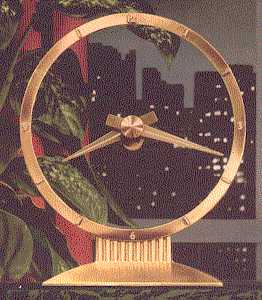Jefferson Golden Hour
by Roger Russell
These
pages are copyrighted.
No portion of this site may be reproduced in whole or in part
without written permission of the author.
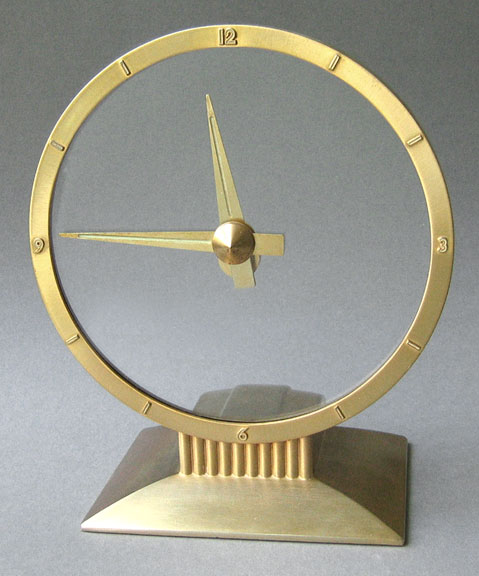
Catalog Number 580-101
This was the first of all the Jefferson Electric clocks to be manufactured. Jefferson later built other models but the Golden Hour was the most popular. The Golden Hour clock remained in production essentially unchanged until the clock division closed in August 1991, a time period of almost 41 years for this single model. About two million of these were sold over the years.
![]()
Golden Hour Clock Production Began in Late 1949
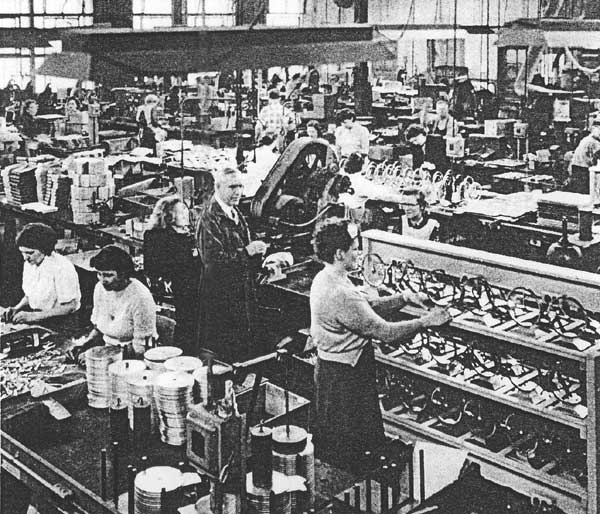
Production started on December 2, 1949. This picture shows the production line at about that time. All clocks were run for 72 hours to insure proper operation before they were packaged and shipped. The date of manufacture for most Golden Hours can be found stamped on the inside of the base. This can be found by removing the two screws that hold the base plate. Sometimes the numbers are a little smeared. The Golden Hour clock remained in production essentially unchanged until August 1991, a time period of almost 41 years for this single model. About two million of these were sold over the years. The initial retail price was $19.95 but went to $22.95 by the following December. It was $23.95 in 1956, $48.00 in 1977 and $70.00 in 1984.
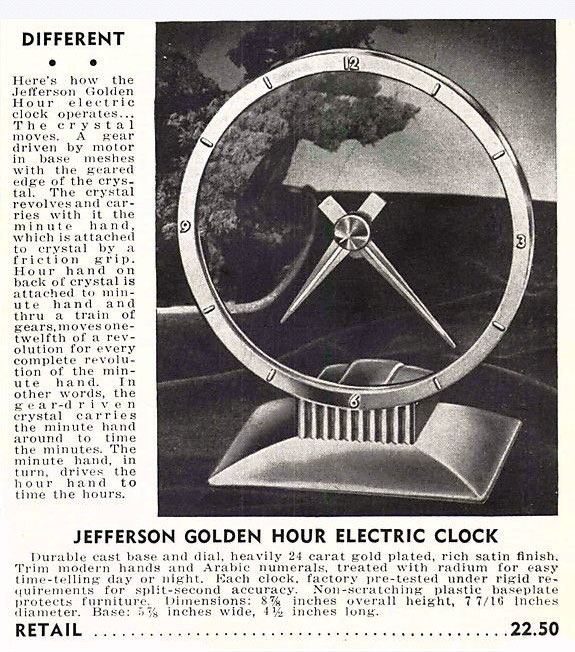
Here is an advertisement for the Golden Hour from a 1952 publication. The word crystal has been used frequently in this ad to describe the glass. When I researched the qualifications for crystal and glass and tried an experiment, I found that the glass used in the clock is not crystal but ordinary window glass. See my page about the Jefferson glass.
Because of the weight and color of the clock, it could be thought of as being made of brass. However, the ring and base are made of a cast zinc alloy. See my page showing a cross section and a metal analysis. They are plated with pure 24-karat gold. See my Gold Reference Page for information about gold and karat ratings. The clock has a brushed satin finish.
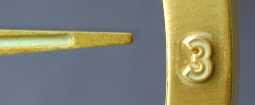 The dial frame ring has raised numerals at 3, 6, 9,
and 12 o'clock as well as raised radial lines at the other hours. Production
began with luminescent paint in the numerals and lines of the hands. The hour
and minute hands also had luminescent paint. These can be seen in the photo at
the right as a very light greenish white. The luminescent material is actually
radium paint and is still radioactive
but now glow very little or not at all in the dark. However, the radium is
still active and has a half life of 1600 years. Later Golden Hour versions do
not have painted luminescent areas. Luminescent paint has been found on Golden
Hours as late as 1965.
The dial frame ring has raised numerals at 3, 6, 9,
and 12 o'clock as well as raised radial lines at the other hours. Production
began with luminescent paint in the numerals and lines of the hands. The hour
and minute hands also had luminescent paint. These can be seen in the photo at
the right as a very light greenish white. The luminescent material is actually
radium paint and is still radioactive
but now glow very little or not at all in the dark. However, the radium is
still active and has a half life of 1600 years. Later Golden Hour versions do
not have painted luminescent areas. Luminescent paint has been found on Golden
Hours as late as 1965.
The glass is mounted in a steel, nickel plated ring gear. It is single strength select grade glass and is 3/32" thick. The retainer ring on the back of the clock) is steel, plated with 24 kt gold. Replacement glass instructions are available including the purchase of shatter resistant acrylic instead of glass.
Dimensions are 8-7/8" high and 4-1/2" deep. The outside diameter of the outer ring is 7-7/16". Weight is 2.3 lbs. The cord and plug are brown plastic.
The plastic bottom cover is Eastman Chemical Products Corp. “Zenite II” and is also known as cellulose acetate butyrate. The early Golden Hours have a maroon colored base plate that shows a rating of 115V.A.C. 60 CY 2.5 watts and patent pending. Later maroon plates have the patent number 2,642,713. This patent is actually for a different clock made by the Etalage Reclame Corporation of New York. Jefferson bought the patent rights and restyled it to become the Golden Hour, Exciting Hour, Golden Minute, Golden View and Golden Helm. For more information, see The Clocks of Leendert Prins
The base plates were later changed to black and have been seen on clocks dating as far back as 10-14-64. These have the patent number and a power rating of 2.5 watts. Later black plates have a date such as J8405 (May 1984) melted into it. The power rating was changed to 3 watts and the patent number is no longer mentioned. All plates, maroon or black, have the UL listed symbol. All molded plates have a key to locate the rear of the plate in the base.
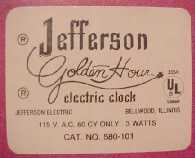 An unusual bottom plate has been found on two Golden
Hours. These are made of fiberglass reinforced maroon plastic sheet material
that is 1/8" thick. There is no molded lettering or a key at the rear.
Instead, there is a self adhesive paper label on the plate. The label is
3-3/4" X 2-7/8". No patent number is mentioned. The clocks are dated
8-78 and 11-79. Both dates are written on the inside of the clock base with a
black marking pen.
An unusual bottom plate has been found on two Golden
Hours. These are made of fiberglass reinforced maroon plastic sheet material
that is 1/8" thick. There is no molded lettering or a key at the rear.
Instead, there is a self adhesive paper label on the plate. The label is
3-3/4" X 2-7/8". No patent number is mentioned. The clocks are dated
8-78 and 11-79. Both dates are written on the inside of the clock base with a
black marking pen.
The Golden Hours are often powered with an International Register synchronous motor located in the base. Other motor sources are the Haydon Mfg. Company and Bowman Electrical Products Corporation. The output gear from the motor gearbox has 27 teeth and rotates at 1/6 rpm. These mate with the rim gear that has 270 teeth. This 10:1 reduction results in the clock face turning at the required 1/60 rpm, or one revolution per hour.
 The hand assembly is made of brass and is 24 kt gold
plated. The picture shows the rear of the hands and the pear shaped
counterweight assembly. The minute hand is located at front of the glass and is
attached to it by friction so that it can be easily turned to set to the
desired minutes. The hour hand and gear assembly is located behind the glass
and can turn freely. A shaft attached to the center of the glass has a gear in
the counterweight gear assembly. The counterweight always stays in a vertical
location and provides a fixed position needed to drive other gears that advance
the hour hand as the glass turns.
The hand assembly is made of brass and is 24 kt gold
plated. The picture shows the rear of the hands and the pear shaped
counterweight assembly. The minute hand is located at front of the glass and is
attached to it by friction so that it can be easily turned to set to the
desired minutes. The hour hand and gear assembly is located behind the glass
and can turn freely. A shaft attached to the center of the glass has a gear in
the counterweight gear assembly. The counterweight always stays in a vertical
location and provides a fixed position needed to drive other gears that advance
the hour hand as the glass turns.
A small counterweight of metal is attached to the rear portion of the hour hand. It's the same shape and can be seen behind the main counterweight near the bottom of the picture. It serves to hold the hour hand in proper position relative to the minute hand. See my page for information on troubleshooting, restoration and improvements of these clocks.
![]()
Here is a portion of one of the earlier manuals that came with the Golden Hour.
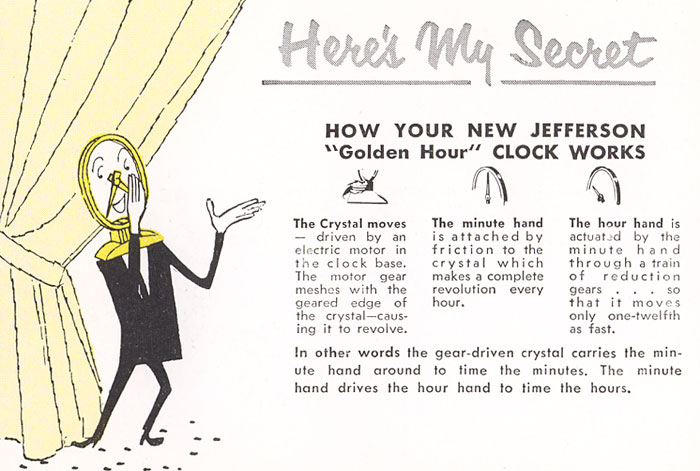

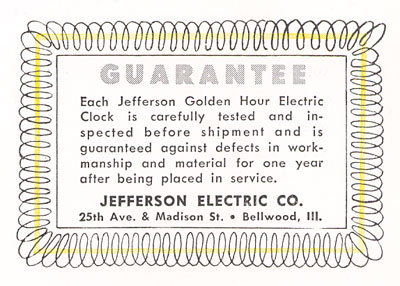
![]()
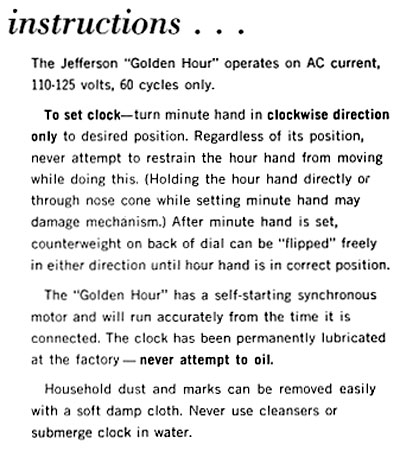
Here
is a copy of a portion of the instruction book that came with the Golden Hour
that I bought from Jefferson about 1980. It replaces the earlier cartoon
manual.
Please note that you should never attempt to oil the clock.
![]()
Various Sales Promotions
Advertising for the Golden Hour began in several different magazines such as the New Yorker (5-13-1950), Coronet (12-1950), jeweler's catalogs and mail order catalogs.
In 1953, Philco purchased 50,000 Jefferson Golden Hour clocks for use in one of their most successful premium programs. The clocks served as an inducement for the consumer to buy Philco TV and buy the console TV instead of their table model.
The Pfister Feed Company used 1,000 Jefferson clocks to persuade the farmers to feed their chickens with their brand of feed. How did they handle the program? Simple: The farmer buys a certain number of feed sacks, and he gets a clock free. This program was so well received that the Pioneer Hybrid Corn Company offered the same program.
Chicago’s Plastone Company, manufacturer of Turtle Wax Auto Wax, used 3,000 Golden Hours as a “dealer loader” for gas station owners.
The New England regional office of the A & P supermarket chain searched for ways in which to get more people into their stores. The answer: free weekly drawings for fine prizes—including 300 Jefferson clocks.
![]()
The picture at the right is a Golden Hour with the
original box, a rare find. Thanks to Steve Speece for the photos from his
collection.
The picture at the left is the Golden Hour with the
end view of the original box. The writing says A Miracle of Luxurious
Precision.
![]()
Literature found in a 1956 jeweler's catalog has the following description:
|
|
|
Golden Hour One of America's favorite gift ideas. Lovely and fashionable in any decorating scheme. The hands of the Golden Hour "float" in clear crystal with no apparent source of movement. 24-kt. gold-plated...brushed satin finish. Dimensions: 8-7/8" overall height, 7-7/16" diameter. $23.95 retail...plus tax |
All Jefferson clocks are fully guaranteed...operate on 110-125 volt, 60 cycle AC current.
![]()
A Golden Hour clock has been found in Canada that has the words MADE IN U.S.A. stamped in the metal at the front edge of the base. This may have been required by the Canadian government in order to sell the clock in Canada.
![]()
Sales Promotion in Time magazine
The promotion notice was included with the May 7, 1951 issue of Time.
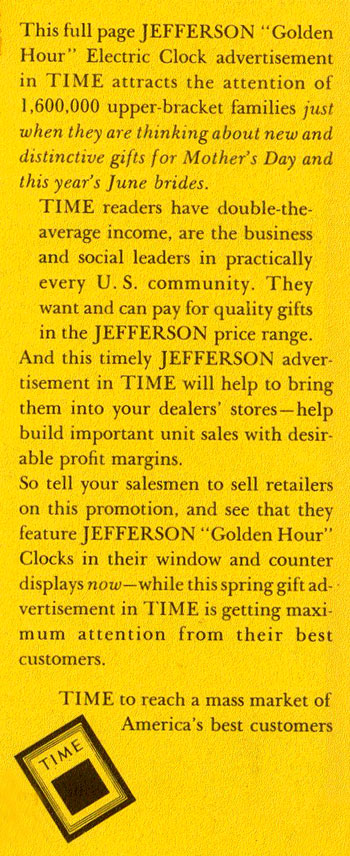
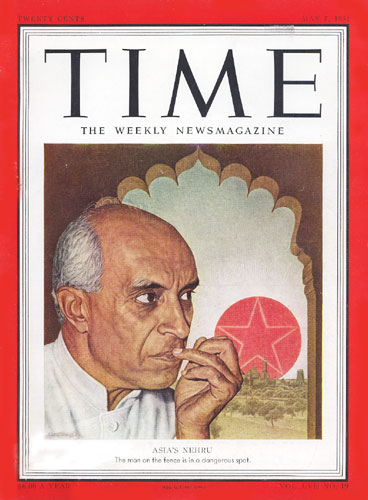
Jawaharlal Nehru was on the cover
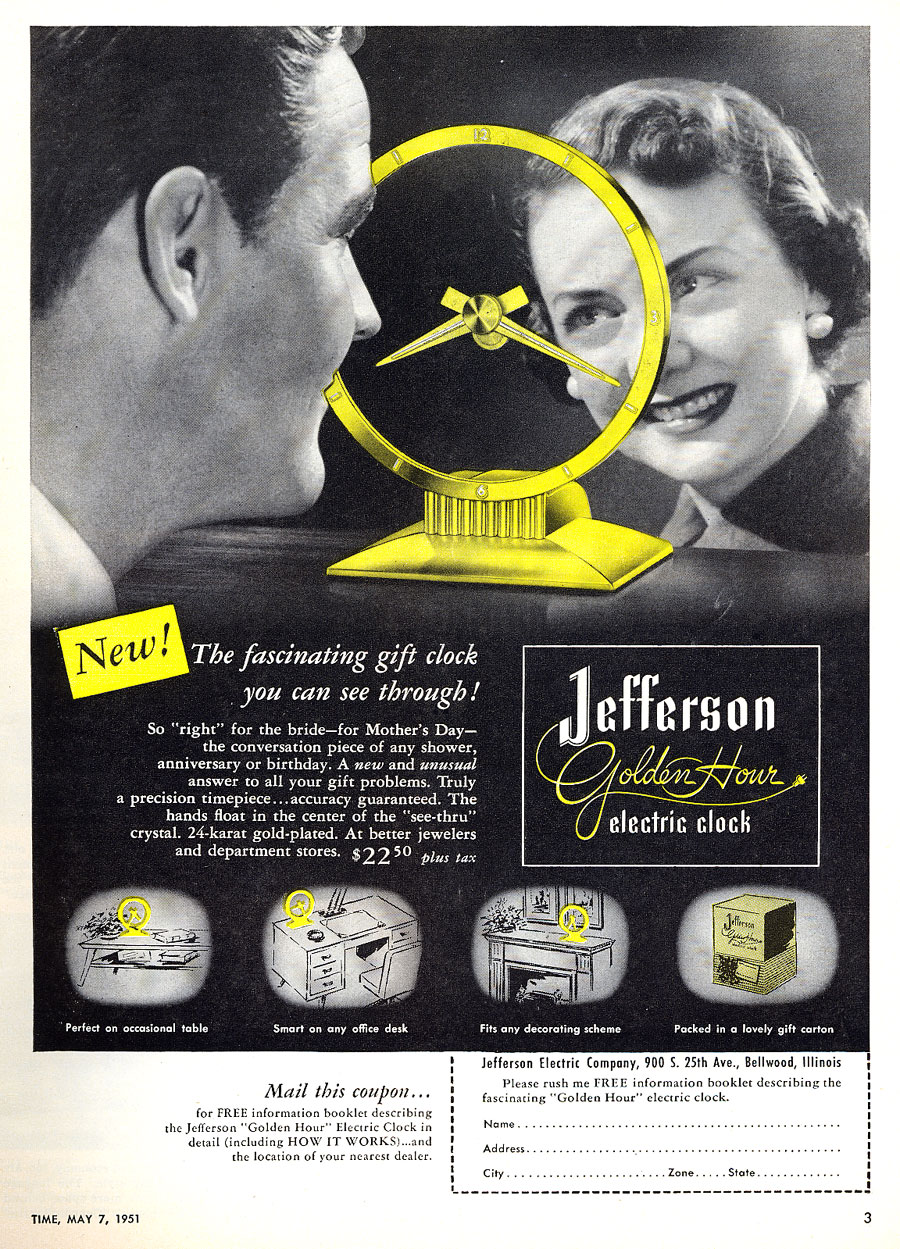
Page Advertisement
![]()

Lucy
is with ABC VP Donn Tatum.
It was an appreciation award presented by the
Radio Television Recording Advertising Charities,
which were helped by Lucy and Desi that year, circa 1955.
![]()
|
About This Site |
||
|
|
More text and pictures about Jefferson will be added as my research continues. Any comments, corrections, or additions are welcome. |
|
|
|
|
Created
by Roger Russell |
